新世纪高职高专英语第一册教案1-Unit(1)分析解析
- 格式:doc
- 大小:59.50 KB
- 文档页数:9
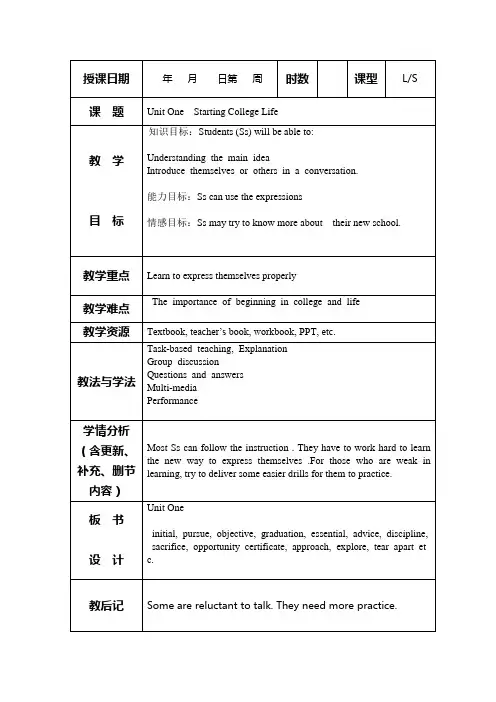
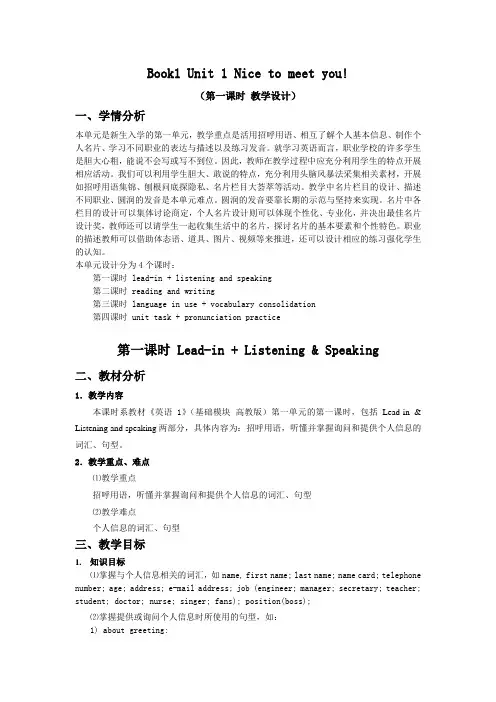
Book1 Unit 1 Nice to meet you!(第一课时教学设计)一、学情分析本单元是新生入学的第一单元,教学重点是活用招呼用语、相互了解个人基本信息、制作个人名片、学习不同职业的表达与描述以及练习发音。
就学习英语而言,职业学校的许多学生是胆大心粗,能说不会写或写不到位。
因此,教师在教学过程中应充分利用学生的特点开展相应活动。
我们可以利用学生胆大、敢说的特点,充分利用头脑风暴法采集相关素材,开展如招呼用语集锦、刨根问底探隐私、名片栏目大荟萃等活动。
教学中名片栏目的设计、描述不同职业、圆润的发音是本单元难点。
圆润的发音要靠长期的示范与坚持来实现。
名片中各栏目的设计可以集体讨论商定,个人名片设计则可以体现个性化、专业化,并决出最佳名片设计奖,教师还可以请学生一起收集生活中的名片,探讨名片的基本要素和个性特色。
职业的描述教师可以借助体态语、道具、图片、视频等来推进,还可以设计相应的练习强化学生的认知。
本单元设计分为4个课时:第一课时 lead-in + listening and speaking第二课时 reading and writing第三课时 language in use + vocabulary consolidation第四课时 unit task + pronunciation practice第一课时 Lead-in + Listening & Speaking二、教材分析1.教学内容本课时系教材《英语1》(基础模块高教版)第一单元的第一课时,包括Lead-in & Listening and speaking两部分,具体内容为:招呼用语,听懂并掌握询问和提供个人信息的词汇、句型。
2.教学重点、难点⑴教学重点招呼用语,听懂并掌握询问和提供个人信息的词汇、句型⑵教学难点个人信息的词汇、句型三、教学目标1.知识目标⑴掌握与个人信息相关的词汇,如name, first name; last name; name card; telephone number; age; address; e-mail address; job (engineer; manager; secretary; teacher; student; doctor; nurse; singer; fans); position(boss);⑵掌握提供或询问个人信息时所使用的句型,如:1) about greeting:Good morning.Hi.Nice to meet you.2) about personal informationWhat’s you name?Where are you from?Which company are you from?2.能力目标⑴学生能听懂关于询问和提供个人信息的对话。
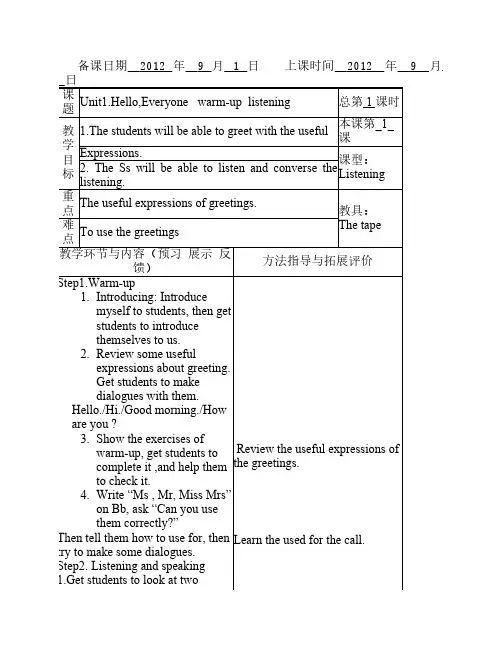
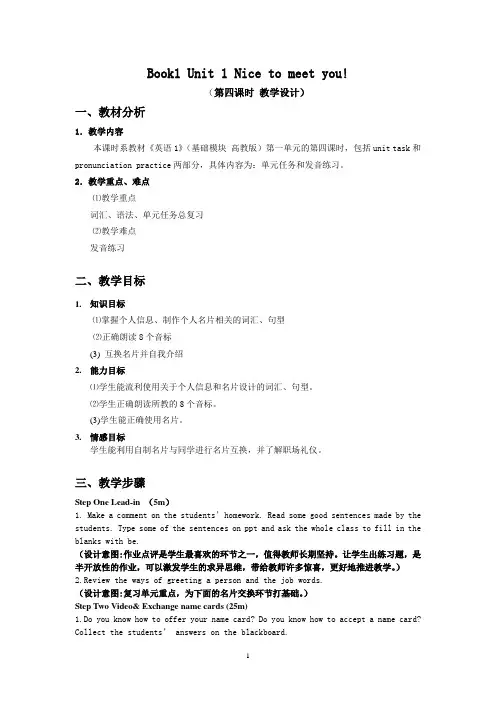
Book1 Unit 1 Nice to meet you!(第四课时教学设计)一、教材分析1.教学内容本课时系教材《英语1》(基础模块高教版)第一单元的第四课时,包括unit task和pronunciation practice两部分,具体内容为:单元任务和发音练习。
2.教学重点、难点⑴教学重点词汇、语法、单元任务总复习⑵教学难点发音练习二、教学目标1.知识目标⑴掌握个人信息、制作个人名片相关的词汇、句型⑵正确朗读8个音标(3)互换名片并自我介绍2.能力目标⑴学生能流利使用关于个人信息和名片设计的词汇、句型。
⑵学生正确朗读所教的8个音标。
(3)学生能正确使用名片。
3.情感目标学生能利用自制名片与同学进行名片互换,并了解职场礼仪。
三、教学步骤Step One Lead-in (5m)1. Make a comment on the students’homework. Read some good sentences made by the students. Type some of the sentences on ppt and ask the whole class to fill in the blanks with be.(设计意图:作业点评是学生最喜欢的环节之一,值得教师长期坚持。
让学生出练习题,是半开放性的作业,可以激发学生的求异思维,带给教师许多惊喜,更好地推进教学。
)2.Review the ways of greeting a person and the job words.(设计意图:复习单元重点,为下面的名片交换环节打基础。
)Step Two Video& Exchange name cards (25m)1.Do you know how to offer your name card? Do you know how to accept a name card? Collect the students’ answers on the blackboard.(设计意图:摸底调查,了解学生对名片礼仪的现有知识。
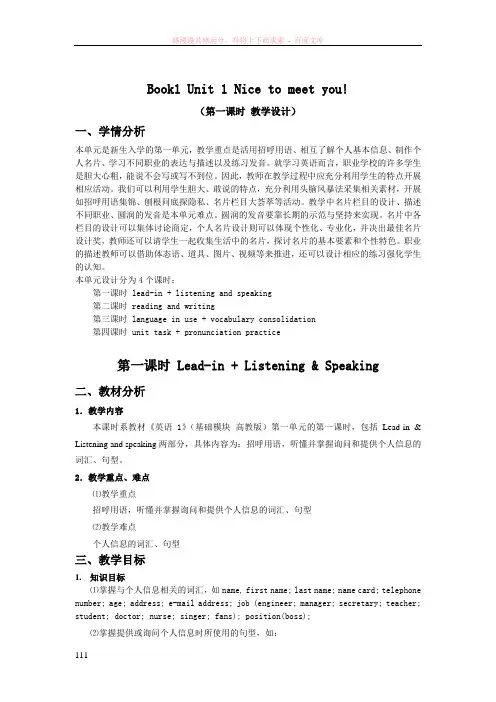
Book1 Unit 1 Nice to meet you!(第一课时教学设计)一、学情分析本单元是新生入学的第一单元,教学重点是活用招呼用语、相互了解个人基本信息、制作个人名片、学习不同职业的表达与描述以及练习发音。
就学习英语而言,职业学校的许多学生是胆大心粗,能说不会写或写不到位。
因此,教师在教学过程中应充分利用学生的特点开展相应活动。
我们可以利用学生胆大、敢说的特点,充分利用头脑风暴法采集相关素材,开展如招呼用语集锦、刨根问底探隐私、名片栏目大荟萃等活动。
教学中名片栏目的设计、描述不同职业、圆润的发音是本单元难点。
圆润的发音要靠长期的示范与坚持来实现。
名片中各栏目的设计可以集体讨论商定,个人名片设计则可以体现个性化、专业化,并决出最佳名片设计奖,教师还可以请学生一起收集生活中的名片,探讨名片的基本要素和个性特色。
职业的描述教师可以借助体态语、道具、图片、视频等来推进,还可以设计相应的练习强化学生的认知。
本单元设计分为4个课时:第一课时 lead-in + listening and speaking第二课时 reading and writing第三课时 language in use + vocabulary consolidation第四课时 unit task + pronunciation practice第一课时 Lead-in + Listening & Speaking二、教材分析1.教学内容本课时系教材《英语1》(基础模块高教版)第一单元的第一课时,包括Lead-in & Listening and speaking两部分,具体内容为:招呼用语,听懂并掌握询问和提供个人信息的词汇、句型。
2.教学重点、难点⑴教学重点招呼用语,听懂并掌握询问和提供个人信息的词汇、句型⑵教学难点个人信息的词汇、句型三、教学目标1.知识目标⑴掌握与个人信息相关的词汇,如name, first name; last name; name card; telephone number; age; address; e-mail address; job (engineer; manager; secretary; teacher; student; doctor; nurse; singer; fans); position(boss);⑵掌握提供或询问个人信息时所使用的句型,如:1) about greeting:Good morning.Hi.Nice to meet you.2) about personal informationWhat’s you name?Where are you from?Which company are you from?2.能力目标⑴学生能听懂关于询问和提供个人信息的对话。

新世纪新视野高职高专英语(电子教
案)Unit1 ___
通过本教案的研究,学生将能够:
理解大学教育的重要性和价值;
研究并掌握与大学教育相关的词汇和表达;
了解大学文化和大学生活的特点;
熟悉大学选课和学术要求;
提升英语阅读、听力、口语和写作能力。
本教案的内容包括以下几个方面:
大学教育的意义和价值
大学教育对个人和社会的影响
大学教育培养的能力和素质
大学教育与职业发展的关系
大学文化与大学生活
大学的学术氛围和社交环境
大学生活的兴趣和挑战
大学生应如何适应大学生活
大学选课和学术要求
大学课程的分类和选择
大学学时、学分和学术成绩的要求大学学业的要求和规划
大学英语教育
大学英语教育的特点和目标
大学英语课程的设置和要求
大学英语研究和提高的方法
阅读和听力训练
阅读和听力的重要性和技巧
阅读和听力材料的选择和使用
阅读和听力练的方法和策略
阅读和听力练习的方法和策略。
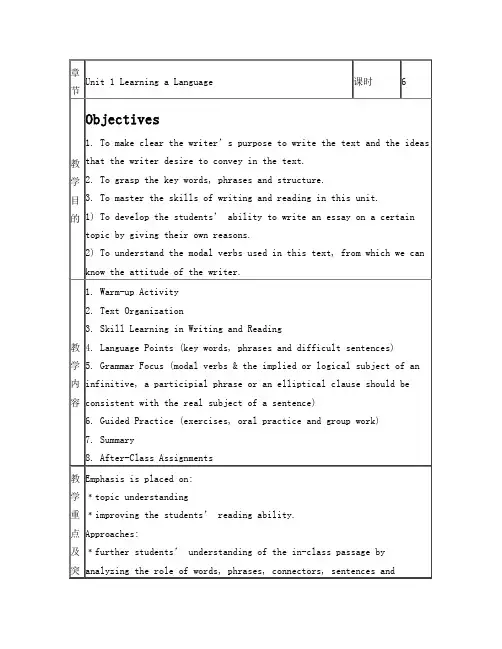
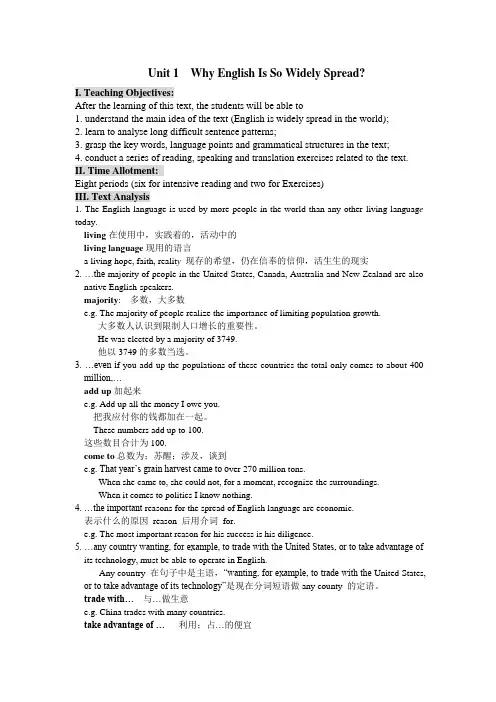
Unit 1 Why English Is So Widely Spread?I. Teaching Objectives:After the learning of this text, the students will be able to1. understand the main idea of the text (English is widely spread in the world);2. learn to analyse long difficult sentence patterns;3. grasp the key words, language points and grammatical structures in the text;4. conduct a series of reading, speaking and translation exercises related to the text. II. Time Allotment:Eight periods (six for intensive reading and two for Exercises)III. Text Analysis1. The English language is used by more people in the world than any other living languag e today.living在使用中,实践着的,活动中的living language现用的语言a living hope, faith, realit y现存的希望,仍在信奉的信仰,活生生的现实2. …the majority of people in the United States, Canada, Australia and New Zealand are also native English-speakers.majority: 多数,大多数e.g. The majority of people realize the importance of limiting population growth.大多数人认识到限制人口增长的重要性。
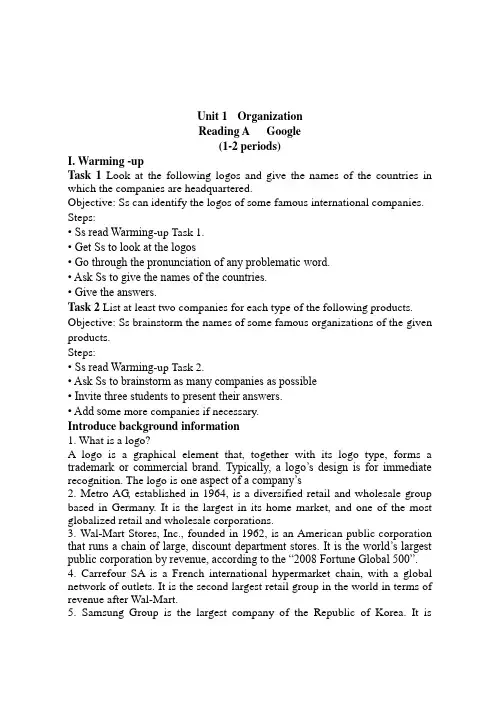
Unit 1 OrganizationReading A Google(1-2 periods)I. Warming -upTask 1Look at the following logos and give the names of the countries in which the companies are headquartered.Objective: Ss can identify the logos of some famous international companies. Steps:• Ss read Warming-up Task 1.• Get Ss to look at the logos• Go through the pronunciation of any problematic word.• Ask Ss to give the names of the countries.• Give the answers.Task 2 List at least two companies for each type of the following products. Objective: Ss brainstorm the names of some famous organizations of the given products.Steps:• Ss read Warming-up Task 2.• Ask Ss to brainstorm as many companies as possible• Invite three students to present their answers.• Add so me more companies if necessary.Introduce background information1.What is a logo?A logo is a graphical element that, together with its logo type, forms a trademark or commercial brand. Typically, a logo’s design is for immediate recognition. The logo is on e aspect of a company’s2. Metro AG, established in 1964, is a diversified retail and wholesale group based in Germany. It is the largest in its home market, and one of the most globalized retail and wholesale corporations.3. Wal-Mart Stores, Inc., founded in 1962, is an American public corporation that runs a chain of large, discount department stores. It is the world’s largest public corporation by revenue, according to the “2008 Fortune Global 500”.4. Carrefour SA is a French international hypermarket chain, with a global network of outlets. It is the second largest retail group in the world in terms of revenue after Wal-Mart.5. Samsung Group is the largest company of the Republic of Korea. It iscomposed of Samsung Electronics, Samsung Heavy Industries and Samsung Engineering & Construction.6. Lenovo Group Limited is China’s largest and the world’s fourth largest personal computer manufacturer. Lenovo mainly produces desktops, laptops, servers, handheld computers, imaging equipment and mobile phone handsets (听筒).7. Nokia Corporation is a Finnish multinational communications corporation. Nokia is focused on wireless and wired telecommunications. It is the world’s largest manufacturer of mobile telephones.II. Guided Reading of the New Words and ExpressionsObjective: Ss can get familiar with the new words and expressions, etc.. Steps:• Ss read the new words and expressions after the teacher, trying to simulate the teacher’s pronunciation and intonation.• Ss read the new words and expressions in clas s individually for 5 minutes. III. Explanation of Language PointsParagraph 2relevant: a. closely connected with the subject you are discussing or the situation you are thinking aboute.g. What experience do you have that is relevant to this position?achieve: v. to succeed in reaching a particular goal or standard by making an effort for a long timee.g. After 10 years of hard work, he finally achieved success in his business. appear to be/do: to give the impression of being or doing somethinge.g. She appeared to be foolish.They appeared not to know what was happening.Paragraph 3fuel: v. to increase something; to make something stronger; to supply something with material that can be burnt to produce heat or powere.g. His words fueled her anger still more.The stored oil could fuel the nation for six months.go public: (of a company) to start selling shares on the Stock Exchangee.g. This company is among the first ones that went public in China. instant: a. happening immediately; (of food) that can be made quickly andeasilye.g. She took an instant dislike to me.instant coffee/instant noodlesParagraph 4acquire: v. to gain possession of; to gain something by one’s own efforts, ability or behaviore.g. The company has just acquired some new properties.She has acquired a good knowledge of English.feature: n. something important, interesting or typical of a place or thinge.g. An important feature of Van Gogh’s paintings is their bright colors.v. to include a particular person or thing as a special featuree.g. The new car features high speed and safety.Paragraph 5in addition to: as well as; besidese.g. In addition to the apples you asked for, I bought you some oranges and bananas.tend to: to be likely to do something or to happen in a particular way because this is what often or usually happense.g. Women tend to live longer than men.When I’m tired, I tend to make mistakes.stay away from: not to go near a particular person or placee.g. I want you to stay away from my home.typical: a. having the usual qualities or features of a particular group or thing e.g. This advertisement is a typical example of their marketing strategy.excel (at/in): v. to be very good at doing somethinge.g. The school excels in sports.She has always excelled at foreign languages.Paragraph 6in terms of: from the point of view of; with regard to; concerninge.g. In terms of environmental protection, this project is excellent.the brain child (of somebody): an idea or invention of one person or a smallgroup of peoplee.g. This festival was the brain child of Tony Smith. serve as: to be suitable for a particular useIV. Exercises• Ss do Task 1 and Task 2 individually.• Check the answers.V. Assignments1. Recite the new words and expressions.2. Pre-reading of Reading B.Unit 1 OrganizationReading B and Writing(3-4 periods)I. Background InformationHead office 总公司Branch office 分公司Business Office 营业部Personnel Department人事部Human Resources Department人力资源部General Affairs Department总务部Finance Department 财务部Sales Department 销售部International Department 国际部Public Relations Department 公共关系部Advertising Department广告部Planning Department 企划部Research and Development Department 研发部II. Explanation of Language Points1. Objective: n. aim, goale.g. reach an objective military objective2. facility n. equipmente.g. health facility electrical facility3. expand v. extend in one or more directionsn. expansione.g. expand with heatexpand domestic demand4. marketing: selling productse.g. marketing strategy marketing idea5. ensure: v. make certain ofe.g. Money doesn’t ensure happiness.6. promote v. try to sell n. promotione.g. promote sales promote cadreIII. Exercises• Ss do Task 1 and Task 2 in pairs.• Check the answers.IV. Writing: Envelope1. Introduce in detail the typical positions of items in an English envelope after asking students to finish task 1.Instructions: Your name and address should go on the upper part of the front of the envelope; the name and address to the person you are writing to should goin the center of the envelope (also the zip code, but if you don’t have it, it will still get to the person). Be sure to put that stamp on it.2. Ask Ss to finish task 2 and 3 with the help of the teacher.3. Ask Ss to finish task 4 in pairs.4. Select some Ss to present their work.V. Assignments1. Recite the new words and expressions.2. Pre-reading of Listening and Speaking.Unit 1 OrganizationListening and Speaking(5-6 periods)I. Listening1. Give Ss a few minutes to read through the printed materials for each listening item.2. Listen to the material for the first time without looking at the book.3. Listen to the material for a second time, and ask Ss to do the exercises from task 1 to task 5 in the section.4. Teacher gives the correct answers and explains the key points for some difficult statements.5. Listen to the material for the third time with a pause after each sentence, and ask Ss to repeat the sentence during the pause.II. SpeakingAsk Ss to work in pairs to introduce each other with reference to some useful expressions below:GreetingHow do you do?I’ve often heard about you.Making introductionAllow me to introduce myself.My name is…I’m…,from…Asking questionsWhere were you born?What do you do in your spare time?Did you grow up here?Why did you choose this major?EndingNice talking to you.Nice to meet you, too.It’s a pleasure to meet y ou.III. AssignmentsDo task1, 2, 3,and 4 in Language Lab.Unit 1 OrganizationMini-project and Language Lab(7-8 periods)I. Mini-projectObjective:Ss can know how to design a web page.Steps:• Grouping.Divide the class into groups. There are several ways: Ss pick up their own partners; Teachers group fast learners with slow learners; Ss find their partners by drawing lots.• Defining the project.Go through the project with the class and clarify requirements. You are advised to do it after Ss study Reading B.• Timing & cooperation.Give Ss the deadline for completion and guidelines on working together. Appropriate time management and job division are likely to be serious problems at the beginning, where basic instructions from the teacher should come in. As Ss get used to the mini-project, they will become more experienced. Remind them that different Ss have different work but everybody contributes to the project. They discuss first and then decide who will do what. • Presentation.Ss present their evidence for completion. In this project, they need to show a written “About Us” page of a company’s website. Ask them to hand in their work after they study the whole unit.II. Language Lab1. Ss do Task 1 to Task 4 in this section individually.2. Check the answers and give explanations if necessary.III. Grammar RevisionBasic Sentence PatternsT may offer the following model:S + Vi.Times flies.Birds sing beautifully.They went on holidayShe'll go swimming.S + Vt. + O.We like EnglishShe wants to help him.I don't know what to do.I think he is right.S + Lv. + PThe compass is mine.The secretary is efficient.The power is off.He looks in good health.He gets excited.S + Vt. + Io. + Do.I sent him a faxI bought a book for Marry?IV. Assignments1. Do task 5 in Language Lab on Page 13.2. Pre-reading of Unit 2.Unit 2 OfficeReading A Secretaries(1-2 periods)I. Warming -upTask 1: Ask Ss to read Mr. Thomson’s schedule for Tuesday. Then write their schedules for today.Objective: Ss can organize their activities in one day and make a time schedule.Steps: 1) Ss read Warming-up Task.2) Go through Mr. Thomson’s schedule with Ss3)Allow three mins for Ss to do the task.4)Ask some Ss to present their work.Task 2: Ask Ss to answer the following questions in group.Table 1Table 2Objective: Ss can get familiar with the new words and expressions, etc.Steps:• Ss read the new words and expressions after the teacher, trying to simulate the teacher’s pronunciation and intonation.• Ss read the new words and expressions in class individually for 5 minutes. III. Explanation of Language PointsParagraph 1a variety of: a lot of things of the same type that are different from each other in some waye.g. The girls come from a variety of different backgrounds.Reflect: v. to show or bw a sign of a particular situation or feelinge.g. The low value of the dollar reflects growing concern about the us economy.Paragraph 2Depend on: be decided bye.g. The price depends on the quality.It depends (on) whether you want to do it or not.Minimum:n.the smallest amount of something or number of things that is possible or necessarye.g. Looking after a cat costs a minimum of$2000a year.handle: v .to do the things that are necessary to complete a job.e.g. Computers can handle huge amounts of data.My secretary will handle all the details.keep track of: to pay attention to someone or something so that you know what is happening to theme.g. It’s difficult to keep track of all the new discoveries in medicine. Operate: v. to use and control a machine or equipment; to rune.g. Mary was experienced in operating the computers.The company operates five factories.Appropriate: adj. correct or suitable for a particular time, situation or purpose e.g. I didn’t feel that this was an appropriate tine to mention the subject of money.Deal with : to take the necessary action, especially in order to solve a problem e.g. They should deal properly and fairly with any complaint.Paragraph 3Efficient: adj. working well and effectively without wasting money or energy e.g. All staff think Maria is a very efficient secretary.Anticipate: v. to expect that something wall happen and be ready for ite.g. It is anticipated that next year the workers, wage will increase. Confidential: adj. spoken or written in secret and intended to be kept secret e.g. Doctors are required to keep patients, records completely confidential. Paragraph 4prospect. a person ,job ,plan, etc, that has good chance of success in the future;a possibility that something you hope for will happene.g. The manager held out bright prospects for me if I would accept of his recovery.Individual. n. one person, considered separately from the rest of the group or societye.g. It is important to know that the virus can be passed from individual.adj. considered separately from other people or things in the same groupe.g. Each individual leaf on the tree is different .pursue: v. to continue doing an activity or trying to achieve something over a long period of timee.g. Christine pursued her acting career with great determination. Challenging: adj. difficult in an interesting or enjoyable waye.g. Teaching young children is a challenging and rewarding job.IV. Exercises• Ss do Task 1 and Task 2 individually.• Check the answers.V. Assignments1. Recite the new words and expressions.2. Pre-reading of Reading B.Unit 2 OfficeReading B and Writing(3-4 periods)I. Background InformationMany newsletters are published by clubs, societies, associations, and businesses, especially companies to provide information of interest to their members, customers or employees. General contents of a newsletter include news and upcoming events of related organization, as well as contact information for general inquiries.II. Explanation of Language Points1. award n. prizee.g. Einstein was awarded the Nobel Prize for his work in physics.award sb. sth.2.gaze at/intoe.g. We gazed up at the stars.3. socialize with sb.e.g. I enjoy socializing with my students after class.III. Exercises• Ss do Task 1 and Task 2 in pairs.• Check the answers.IV. Writing: Agenda1. Introduce in detail the format and typical items of an agenda. Instructions: An agenda is a written list of topics or matters to be discussed at a meeting. The format of an agenda is comparatively fixed. The first four items and the last three are usually the same for all meetings, but the rest are different according to what the meeting is about.2. Ask Ss to finish task 1 with the help of the teacher.3. Ask Ss to finish task 2 in pairs.4. Select some Ss to present their work.V. Assignments1. Recite the new words and expressions.2. Pre-reading of Listening and Speaking.Unit 2 OfficeListening and Speaking(5-6 periods)I. Listening1. Give Ss a few minutes to read through the printed materials for each listening item.2. Listen to the material for the first time without looking at the book.3. Listen to the material for a second time, and ask Ss to do the exercises from task 1 to task 5 in the section.4. Teacher gives the correct answers and explains the key points for some difficult statements.5. Listen to the material for the third time with a pause after each sentence, and ask Ss to repeat the sentence during the pause.II. SpeakingAsk Ss to work in pairs to practice making an appointment with reference to the instructions below:Role A Receptionist●Greet the caller.●Set a day and time for the appointment.●Get the caller’s telephone number.●Confirm the information.●Close the conversation.Role B Caller●State who you are and the wish to make an appointment.●Agree to the date and time.●Give your telephone number.●Thank the person.III. AssignmentsDo task1, 2, 3,and 4 in Language Lab.Unit 2 OrganizationMini-project and Language Lab(7-8 periods)I. Mini-projectObjective:This project asks Ss to design a travel route and make an itinerary (旅行计划). It helps to train Ss to be competent in travel planning. Ss compare different airlines, hotels and places of interest to decide which is the most suitable. Its concept comes from real life, hence it’s authentic. In o rder to complete it successfully, Ss should use the knowledge and skills they’ve learned from other activities in the unit.Steps:●Grouping. Divide the class into groups. There are several ways: ss pick uptheir own partners; teachers group fast learners with slow learners; ss find their partners by drawing lots.●Defining the project. Go through the project with the class and clarifyrequirements. You are advised to do it after Ss study Reading B.●Timing & cooperation. Give Ss the deadline for completion and guidelineson working together. Appropriate time management and job division are likely to be serious problems at the beginning, where basic instructions from the teacher should come in. as Ss get used to the mini-project, they will become more experienced. Remind them that different Ss have different work but everybody contributes to the project. They discuss first and then decide who will do what.●Presentation. Ss present their evidence for completion. In this project, theyneed to show a written travel itinerary and explain it orally in class. Ask them to do that after they study the whole unit.II. Language Lab1. Ss do Task 1 to Task 4 in this section individually.2. Check the answers and give explanations if necessary.III. Grammar Revision时态是英语谓语动词通过自身的变化来表示动作发生的时间和所处的状态的各种形式。
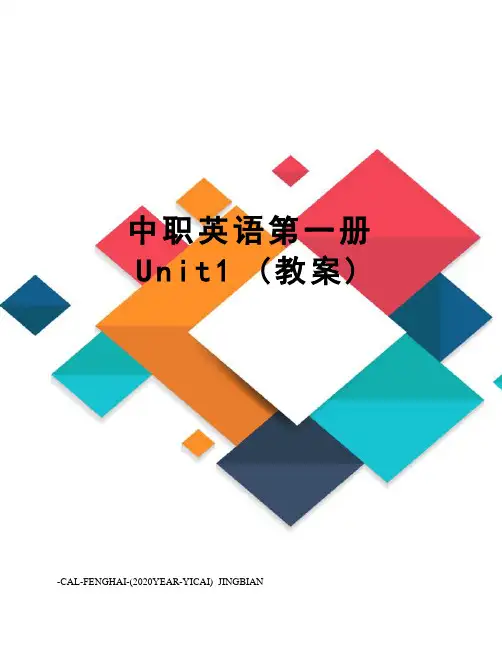
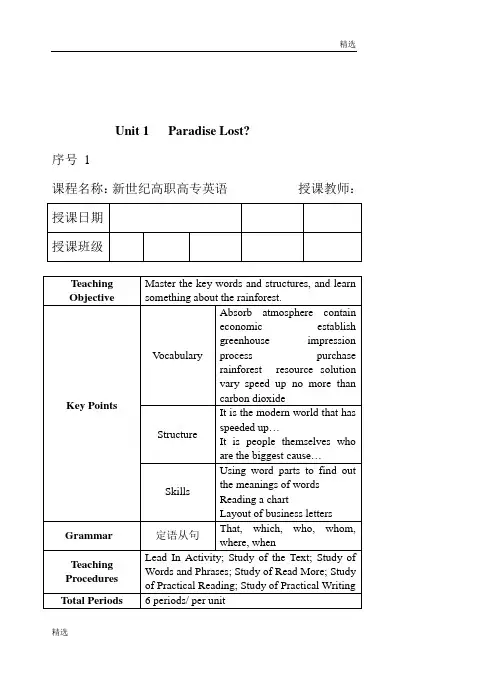
Unit 1 Paradise Lost?序号1课程名称:新世纪高职高专英语授课教师:Unit 1 Paradise Lost?授课内容:1. Understand the Text:Paradise Lost?2. Explain the key words and structures in the text.目的要求:1. Understand why Paradise Lost2. Master the key words and structures in the text 有关记录:板书设计:Paradise Lost?→Paradise Lost:It was p ublished in 1667 and tells the story of Satan’s (撒旦) rebellion against God and his expulsion from heaven and the subsequent temptation and expulsion of Adam and Eve from the Garden of Eden.→Rainforest :Woodland is characterized by lush vegetation and heavy rainfall.→Christopher Columbus (1451-1506):He made a total of four trips to the Caribbean and South America during the years 1492-1504.→Amazon (River)The Amazon River is the largest river in the world. With its more than 1,000 tributaries, the Amazon River network encompasses almost half of South America.I.Lead in( 15 minutes)Ask the students to discuss in pairs the importance of forest and why Paradise Lost, and then ask some pairs to tell their opinions to the whole class.Q1: How did Columbus think of the rainforest?A: He thought it was most beautiful and quite different from that in Europe, with flowers and fruits, and little birds singing sweetly.Q2. What is special about Columbus’ description of the rainforest?A: His description was the first known written one about the rainforest.Q3. What are the oldest communities of living things on the Earth?A: In the author’s view, the rainforests are the oldest.II. Teaching ( 65 minutes)1. Background Information ( 5 minutes)1) The masterpiece of the English poet John Milton (1608 - 1674) and one of the greatest poems in world literature. It was published in 1667 and tells the story of Satan’s (撒旦) rebellion against God and his expulsion from heaven and the subsequent temptation and expulsion of Adam and Eve from the Garden of Eden.2) Woodland is characterized by lush vegetation and heavy rainfall. Rainforests are the world’s most biologically d iverse ecosystems. Although they cover less than 10 percent of the Earth’s surface, tropical rainforests provide habitat for 50 to 90 percent of the world’s plant and animal species. Tropical rain- forests are called the “jewel of the Earth,” the “Earth’s lungs,” and the “world’s largest pharmacy” because of the large amount of natural medicines discovered there.The largest tropical rainforests exist in South America’s Amazon basin (the Amazon Rainforest), in the equatorial portions ofthe Democratic Republic of Congo, and in much of Indonesia. Temperate rainforests, dominated by only a few species of trees, are found along the Pacific coast of North America from Alaska through Washington state, in the former Yugoslavia, and in parts of Japan. 3) Italian Spanish navigator who sailed across the Atlantic Ocean in 1492, in an attempt to find a shorter route to India. He made a total of four trips to the Caribbean and South America during the years 1492-1504. He achieved fame by making landfall in the Amer icas, which he later called the “New World.” The arrival of his ships in the Western Hemisphere was one of the pivotal events in world history. It opened up a new world for Europeans and initiated the spread of Western civilization to a new hemisphere.2. Developing vocabulary (30 minutes)1)description n.a statement or a piece of writing that tells what sth. or sb. is likee.g.I gave the police a description of the stolen jewellery.e.g.The beauty of the Rockies is beyond description.Extended words: describe v. descriptive adj.2) beat v.defeat (a competitor), or do or be better than (sb. or sth.)e.g. We played the top class at football but we couldn’t beat them.e.g. The room wasn’t much, but it beat driving to a hotel 20 miles away.3)fragile a.easily damaged, broken, or harmede.g. Be careful with that vase —it’s very fragile.e.g. I felt rather fragile (= weak) for a few days after the operation.Extended words: dominant adj.domination n.4) remaining a.still left or still existinge.g. The United States has withdrawn the remaining staff from its embassy.e.g. The three parties will meet next month to work out remaining differences.Extended words: remain v.5) clear v.remove or get rid of whatever is blocking or fillingsth., or move people away from (a place)e.g. I’ll make the coffee if you’ll clear the table.e.g. Paul helped his elderly neighbor by clearing her path of snow/clearing snow from her path.e.g.After the bomb threat, police cleared the area until it was searched.6) establish v.grow, or cause a plant to grow, successfully a new placee.g. The new owners established an avenue of poplars.e.g. Keep the area weeded to allow the seedlings to establish.Extended words: establishment v.7) varied a.having or showing many different types, or changing oftene.g. It is essential that your diet is varied and balanced.e.g.Before his election to the presidency, Mitterrand had enjoyed a long and varied career.Extended words: vary v.variation n. variety n. various adj.8) process n.a series of actions to achieve an aim; a series of changes that happen naturallye.g. This decision may delay the process of European unification.e.g. She arrived at the correct answer by a process of elimination.e.g. Scientists wanted to find out how the process of agingcould be slowed down.9) absorb v.take sth. in, especially graduallye.g. The drug is quickly absorbed into the bloodstream.e.g. In cold climates, houses need to have walls that will absorb heat.10) economic a.of or relating to economicse.g. Here I provide a qualitative assessment of the current economic reforms.e.g. The pace of economic growth is picking up.Extended word: economy n.11) renewable a.(of a form of energy, resource) able to besustained or renewed indefinitely, either because of inexhaustible supplies or because of new growth; (of an official document) capable of being lengthened for an extra period of timee.g. Plans to increase renewable energy sources such as wind and wave power are welcomed by environmental pressure groups.e.g. An annually renewable contract is signed.12)sustainable a.causing little or no damage to theenvironment and therefore able to continue for a long timee.g. A large international meeting was held with the aim of promoting sustainable development in all countries.e.g. Try to buy wood that you know has come from a sustainable source.Extended word: sustain v. sustainability n.13) solution n.the answer to a probleme.g.When you finish doing the crossword, the solution is on the back page.e.g. She just seems so unhappy and I don’t know what the solution is.Extended word:solve v.3.Detail study of the text (30 minutes)Paragraph One1) Comprehension QuestionsQ:How did Columbus think of the rainforest?A:He thought it was most beautiful and quite different fromthat in Europe, with flowers and fruits, and little birdssinging sweetly.2) Main ideaColumbus’ first description of rainforests.Paragraph Two1) Comprehension QuestionsQ: What is special about Columbus’ description of the rainforest?A:His description was the first known written one about the rainforest.2) Main ideaAlthough beautiful, rainforests are fragile.3) Difficult sentences“It remains hard to beat.”The written description of a rainforest in the New World hasalways been one of the best of its kind.Paragraph Three1) Comprehension QuestionsQ: What are the oldest communities of living things on the Earth?A: In the author’s view, the rainforests are the oldest.2) Main ideaThe city of London was once covered by rainforests.Paragraph Four1) Comprehension QuestionsQ:What do you know about the rainforests in the world today?A:The rainforests cover no more than seven percent of the earth’s surface today.2) Main ideaToday rainforests only exist in a small part of the world.3) Sentence structureno/not more than: used to emphasize how small a number or amount ise.g.There are beautiful mountains not more than ten minutes’ drive away.e.g.Each box requires no more than a few hours of labor to build.Paragraph Five1) Comprehension QuestionsQ: What is “the secondary growth”?A: “The secondary growth” refers to the new growth after theoriginal growth has been destroyed.2) Main ideaThe effect of the clearing of rainforests.Paragraph Six1) Comprehension QuestionsQ: How does the modern world speed up the process of destruction?A: Modern technology doubtlessly increases efficiency when people try to cut down trees.2) Main ideaModern technology speeds up the destruction.3) Sentence structurebe to blame: be responsible for sth. that happense.g.The driver was not to blame for the traffic accident.e.g.The policy is partly to blame for causing the worstunemployment in Europe.Paragraph 7:1) Comprehension QuestionsQ: Who is to blame for the destruction of rainforests?A: It is human beings that are to blame for such destruction.2) Main ideaHuman beings are the biggest cause of destruction.Paragraph 8:Q: How does the land become desert according to the passage?A: When the trees are cut down, the soil washes away easily.2) Main ideaThe negative effect on land, climate, global temperature.3) Difficult sentences“The gas rises and traps the sun’s heat in much the same way as the glass of a greenhouse, leading to a slow but steady build-up of temperature.”The gas of carbon dioxide in the air absorbs the heat of the sun just as a glass greenhouse does in a sunny day, thus increasing the global temperature over the years.Paragraph 9:Q: What caused the problem mentioned in this passage?A: The problem is mainly caused by the governments that have to pay their debts, the settlers who need money to feed theirfamilies, and the companies that want to make profits.2) Main ideaThe economic origin of the problem and the solution.3) Difficult sentences“On the other hand, by purchasing renewable rainforestproducts, and demanding sustainable harvesting of rainforest resources, we all can be part of the solution and it is humanbeings that will be saved.”On the other hand, if we buy recyclable wood products and insist on a type of inexhaustible rainforest resources for repeated uses, we are then already part of the solution to the problem ofrainforests and we human beings will be saved.III. Exercise ( 10 minutes)Practice Ex. IIV. Assignments1.Review the text and the key words/phrases2.Finish off Ex. II – Ex. VI3.Preview Grammar; Reading skills; Practical reading andwritingV. Expand1. Read the article “Why I Came to College”(Book: Human Nature )2. Online learningUnit 1 Paradise Lost?序号2课程名称:新世纪高职高专英语授课教师:授课内容:1. Grammar: Attributive Clause2. Reading skills: Understanding Paragraphs: How to Identify the Topic3. Practical Reading: Reading the Environmental Diagrams4. Practical Writing: Agenda目的要求:1. Master the use of Attributive Clause2. Master the reading skill:Understanding Paragraphs: How to Identify the Topic3. Learn how to read the Environmental Diagrams4. Learn how to write an Agenda有关记录:板书设计:Unit 1 Paradise Lost? Grammar –Attributive ClauseI.Review the text (15 minutes)1.Check the assignments2.Summarize the textOnce the most beautiful and oldest communities of living things on the earth, the rainforests are now being destroyed. The cause of the destruction lies in man’s craziness for land and money. To make things worse, modern technology available to man has sped up the horrible process of destruction. The shrinkage of rainforests has disastrously led to the shortage of water sources and the warming-up of the globe. Nevertheless, there is still hope for a solution to this problem if human beings take some preventive measures.II. Grammar Tips –Article(15 minutes)1.Note:1)在限制性定语从句中,当关系代词在从句中作宾语时,在绝大多数情况下都可以省略。
《高职英语》第一册课程整体教学设计1.课程基本信息课程名称:高职英语课程类型:公共基础课所属系部:商贸系学时:58学分:4授课对象:物流高职091、营销高职091、会电高职091学生开课学期:第1学期制定时间:2009年11月2.课程的性质和特色2.1 课程性质本教学大纲适用于五年制高职学生的英语学习,为公共必修课,是一门培养基础英语学习者四项基本技能的重要课程。
本课程的任务是:激发和培养学生学习英语的兴趣,使学生树立自信心,养成良好的学习习惯和形成有效的学习策略,发展自主学习的能力和合作精神;使学生掌握一定的英语基础知识和听、说、读、写技能,形成一定的综合语言运用能力;培养学生的创新精神;帮助学生了解世界和中西方文化的差异,拓展视野,培养爱国主义精神,形成健康的人生观,为他们的就业、升学、终身学习和发展打下良好的基础。
2.2 课程特色此次出版的为高职英语的第三次修订的教材。
全书编写体例相同,每个教学单元均由听、说、读、写(译)及相应的配套练习册组成。
具有以下特点:(1)听说训练,贴近生活(2)精读材料和补充读物,侧重选用本单元话题相关的语言材料(3)语法不强调完整性和系统性,基础语法作为附录,附在书后,既可作必修教学内容,也可作学生的自学材料。
3.课程教学设计的思路和原则3.1设计思路3.1.1根据职业能力培养的需要,密切联系学生生活实际和专业特色。
3.1.2 教师创造良好的客观条件,实施多元情境化教学。
3.1.3 整个教学过程项目化、立体化,强调学生的自主性、师生的互动性。
3.1.4 整个教学过程体现以学生为主体,尊重个体差异,突出教学的实践性。
3.2基本原则3.2.1变单一智能开发为多元智能开发。
3.2.2 理论实践一体化安排。
3.2.3 实用为主,够用为度。
4.课程的目标设计4.1课程总体教学要求依据:就业岗位的要求和《高职高专教育英语课程教学基本要求》。
在初中英语教学的基础上,进一步传授必要的基础知识,强化基本技能训练,培养学生用英语进行交流的能力,为学生以后有效地开展专门用途英语训练,为步入社会打好基础。
课题序号课题序号授课日期授课日期 第 周 月 日(星期日(星期 ) 授课班级授课班级授课课时授课课时 授课形式授课形式 授课章节授课章节名 称Unit 1 Hello , Everyone! Listening and speaking 使用教具使用教具Tape recorder 教学目的教学目的1. Students Students will will will great great great each each each other other other and and and learn learn learn to to to introduce introduce themselves. 2. Students should master some useful words and expressions. 3. Students Students will will will practice practice practice their their their listening listening listening skills skills skills and and and oral oral English. 教学重点教学重点Students will learn how to introduce themselves and train their listening skill. 教学难点教学难点Students Students will will will master master master some some some useful useful useful expressions expressions expressions and and and finish finish the listening. 课外作业课外作业Copy the new words. 教学步骤教学步骤教学内容教学内容 教学方法及双边活动活动 Step 1 Step 2 Warm up 1 Free talk : Eg: Eg: Good Good Good morning, morning, morning, What What What’’s s your your your name name please? How old are you ? Where are you from? 2 2 Make Make Make students students students look look look at at at the the the pictures pictures pictures on on part one and complete the conversations with the correct sentence from the box. 3 3 Lead students Lead students to to read read read the title on part the title on part two .Then use them to role-play a conversation. Listening and speaking Part A 1 1 Look at Look at the picture and guess what is their relationship. 2 Listen again and underline the greetings and introductions in he conversation. 3 Pair work Lead Lead students students students to to to look look look at at at the the the useful useful expressions. expressions. Then Then Then make make make them them them in in in pairs pairs and introduce themselves to their partners. 4 Group work Work Work in in in groups groups groups of of of three three three and and and complete complete the conversation in Part4. Then act it out. Part B 1 Pre-listening Learn the new words. 2 While-listening Listen Listen to to to the the the tape tape tape for for for one one one time, time, time, try try try to to complete the chart. Step 3 Listen again and and finish finish finish the tick true or the tick true or false. 3 Post-listening 1) 1) Teacher Teacher Teacher will will will explain explain explain some some some language language points . 2) Pair work : ask and answer the questions with the partner , then design a student ID for him/ her. Home work Copy new words 授课主要内容或板书设计授课主要内容或板书设计Listening and speaking 1.Got it 2.Nice /please to meet you. 3.Have you met…? 4.given / first name family / last name What’’s your name? 5.WhatHow old are you ? When and where were you born? Where are you from? What are you studying?课题序号课题序号授课日期授课日期 第 周 月 日(星期日(星期 ) 授课班级授课班级授课课时授课课时 授课形式授课形式 授课章节授课章节名 称Unit 1 Hello , Everyone! Reading and Writing 使用教具使用教具Tape recorder 教学目的教学目的1. Students will learn some useful words and expressions. 2. Students should develop their basic skills of listening , speaking , reading and writing. 3. Students can set up the correct view of consumption. 教学重点教学重点1. Students Students should should should have have have a a a good good good comprehension comprehension comprehension of of of the the passage. 2. Students will train their reading strategies.教学难点教学难点Students will master some useful words and expressions 课外作业课外作业Write down a passage to introduce yourself. Remember some useful language points 教学步骤教学步骤教学内容教学内容 教学方法及双边活动活动 Step 1 Step 2 Step 3 Step 4 Lead in 1 Free talk : What What do do do you you you like like like best, best, best, food food food clothes clothes clothes , , books or else? Name a few things that you like best. Pair work (ask an answer) Eg: What do you like best? What What’’s your hobby? Which is your favorite , … or …? I like …best because … I’I’m interested in m interested in … My favorite … is … While-reading 1)Skimming Listen to the tape and read the text quickly , try to find out what Jenny likes and how she spends her money. 2) Scanning Students read the text carefully and finish Exercise . Post-reading Group work (1): Jenny made a a lot lot lot of of statement about herself herself , , , try try try to to to find find find some some some and and and retell retell retell in in groups. Drills: Finish Exercise 4. Group work(2): Students will try to introduce themselves to to their their their group group group members members members , , , then then then teacher teacher will will choose choose choose some some some students students students to to to give give give their their speeches in class. Discussion Do you think as a student whether Jenny Jenny’’s expense is reasonable, why? Step 5 Homework Write down a passage to introduce yourself. Remember some useful language points.授课主要内容或板书设计授课主要内容或板书设计Reading and writing 1.favorite : n. / adj eg : Swimming is my favorite. My favorite sports is swimming. 2 .spend + money / time + doing sth On sth Eg: I spent two hours doing my homework. I spent 100 yuan on books. 3. save up 4. go to the movies Go to Karaoke 5.send text messages 课题序号课题序号授课日期授课日期 第 周 月 日(星期日(星期 ) 授课班级授课班级授课课时授课课时 授课形式授课形式 授课章节授课章节 名 称 Unit 1 Hello , Everyone! Language in use 使用教具使用教具common 教学目的教学目的1.Students will read the vowels and set some more examples. 2.Students will know the usages of wh-questions. 教学重点教学重点Students will know the usages of wh-questions. know the usages of wh-questions.教学难点教学难点Students will finish the exercises in the workbook. 课外作业课外作业workbook 教学步骤教学步骤 教学内容教学内容 教学方法及双边活动活动 Step 1 Step 2 Revision Review Review some some some useful useful useful words words words and and and expressions expressions in last class. Eg: would like to do Spend money / time doing sth on sth go to the movies save up Language in use A. Phonetics 1 1 Make Make Make students students students read read read the the the following following following vowels vowels and words . Teacher will correct their pronunciation pronunciation and and and make make make them them them set set set some some some more more examples. eat meat leave cheap bill sit fish hit work bird church fur forget address ago supper 2 Drill Make students finish part2: Find the given vowel in each sentence. B. Grammar 1 W e use am, is , are , , do do and does in questions that need a yes or no answer. (一般疑问句) 2 we use wh-questions when we want specific information. (特殊疑问句) Drills : Students read the examples and finish part3. Pair work: Write five questions using who, what , when , where where , , , why why why , , , are are are you you you or or or do do do you you you . . . Then Then interview each other. Step 3 C. V ocabulary 1. 1. Complete Complete Complete the the the family family family tree tree tree with with with the the the words words from the box. 2. 2. Make Make Make students students students finish finish finish part part part 6 6 6 and and and read read read the the sentences together. Homework 授课主要内容或板书设计 授课主要内容或板书设计。
“外研版”中职国规英语教材基础模块(修订版)第一册Unit 1 School becomes interesting.一、单元整体解读及分析二、分课时教学设计第1课时2. 匹配教师展示学校平面图。
通过提问,请学生将课程与上课地点匹配。
1) Where do we have these classes?2) All these classes below are called subjects. The classes in labs are called2. 模拟对话3. 自主对话第2课时2. 词汇学习播放听力(第一遍)Read and fill in the form.第3课时2. 学生展示作业1.阅读Read and learn2)连句成段表述Match the words with the pictures.第4课时2.阅读课文,回答问题1) Why did Schulman attend avocational school?2) When is the Speech Day?2.绕口令教师要求学生练习绕口令。
1) Silly sheep weep and sleep.2) I wish you were a fish in my dish.作者简介:沈碧红,中共党员,中学一级。
从教十年,一直坚守在中职英语教育第一线。
曾获得“外研社杯”全国中职英语教师基本功比赛一等奖和教学设计二等奖,慈溪市“青年骨干教师”和“教坛新秀”荣誉称号。
辅导学生参加各类英语类竞赛获得全国二等奖,浙江省一二三等奖。
系浙江省与宁波市优秀指导教师和慈溪市“五四奖章”获得者。
Unit 1 College EducationTEACHING OBJECTIVE1. Master the key words and structures;2. Try to understand why people go to college for further studies so as to have enough education for a good job;3. Discuss the text among students and offer their opinions on the topic;4. Develop the students’ listening and speaking skills;5. Learn how to fill in the form of personal information.TEACHING TIME: 4 periods/weekIMPORTANT POINTS:1. vocabulary (academic, advanced, beyond, degree, executive, graduate, major, master, privilege, require, research, reserve, serve, talented, variety, view...as, in addition to)2. To master some useful expressions (the more..., the more...; either...or)3. Study dialogues and practiceDIFFICULT POINTS:1. Reading text2. Some words (academic, advanced, beyond, major,talented, variety, view...as, in addition to)3. Practical writing.TEACHING AIDS: Blackboard, chalks, tape-recorder, CDTEACHING APPROACHES: Task Based Language Teaching, Communicative Teaching MethodTEACHING PROCEDURE:I.Lead In1.Warm up activities1)Greetings (T-Ss; Ss-Ss)A. Good morning/ afternoon/ evening.B. How was your military training?C. What do you expect about college life?2) Question-discussingA. You have a lot of choices after you graduate from high school, such as going to college, finding a job or joining the army. What would you like to do? Why?2. Background information1) Education in the United StatesEducation in the United States consists of education in elementary school, secondary school, middle school, high school, community college, junior college, college, institute and university.After high school, the majority of students go on to college. Undergraduate studies lead to a bachelor’s degree, which is generally what Americans mean when they speak of a “college diploma”. The bachelor’s degree can be followed by professional studies and graduate studies, which lead to master’s and doctoral degrees. American public schools are free and open to all at the elementary and secondary level (high school), but public universities charge tuition and have competitive entrance requirements.2) Cyndi LauperAmerican singer, vocalist, movie star who has released a lot of albums. Cyndi Lauper (full name: Cynthia Ann Stephanie Lauper Thornton), was born in Brooklyn, New York on June 22nd 1953. She took up playing the guitar and writing lyrics at the age of 12. The first song she learnt to play was “Greensleeves”. In the mid-70s she performed as a vocalist with various cover bands in the New York metropolitan area. II. Reading of the text1. Global readingQuestions and AnswersDirections: Skim the paragraphs for answers to the following questions.Paragraph 1:Question: Why do most of high school graduates choose to go to college? Answer: About 75% of jobs require some education or technical training beyond a high school degree.Paragraph 2:Question: What is the purpose of college education according to this paragraph? Answer: On one hand, a college education is preparation for a career. On the other hand, it is a kind of preparation for one’s future life.Paragraph 3:Question: What do adults of all ages want to do today in the U.S.?Answer: Adults of all ages come back to college either for career advancement or personal growth.Paragraph 4:Question: What does the rising number of Americans with a bachelor’s degree show? Answer: It shows the faith of Americans in the value of education.2. Detailed readingLanguage points and the paraphrases of difficult sentences:1.pay: v.1) give money in order to buy sth. 支付,付清;缴纳e.g. I pay the cashier $500 for the computer.I paid $150 for that camera.2)discharge or settle (a debt or an obligation) 偿还,抵偿;补偿e.g. Have you paid the electricity bill for the last month yet?2.attention: n. concentration, mental focus 注意;注意力e.g. Give your whole attention to what you are doing.3.the more..., the more...: used for saying that sth. is increasing in number or degreeall the time 越……,越……e.g. The more angry he became, the more she laughed at him.4.earn: v.1)receive money for work that you do 赚得,挣得e.g. Some students earn pocket money by mowing lawns for their neighbors.2)acquire or deserve as a result of effort or action 博得;赢得e.g. They earned a reputation as hard workers.5.accept: v.1)receive (sth. offered), especially with gladness 接受,领受e.g. I’ve received a gift from my brother.2)regard as proper, usual, or right 承认,认可e.g. Such customs are widely accepted.6.Although Cyndi made it without a high school degree, most people don’t. Paraphrase:In spite of the fact that Cyndi was successful in her career without a high school degree, most people usually are not so successful without a high school degree.4. shrug: v. raise shoulders and then lower them, especially to show that you are not interested in something or that you do not know or care about something 耸(肩)(表示对…置之不理、不知道、不在乎)“Where’s Dad?” “How should I know?” replied my brother, shrugging.7.training: n. the process of teaching or learning a skill or job 训练e.g. Nurses have to receive several years of training.8.beyond: prep.1)outside the range of 超出e.g. Understanding this article is beyond my capacity.2)on or to the further side of 在……的那边e.g. The road is beyond that hill.3)(of time) later than 迟于e.g. Some cafés keep open beyond midnight.9.outearn: v. earn more than 比……赚得多e.g. General managers usually outearn general employees.10....the highest incomes of all are earned by people with advanced degrees. Paraphrase:...people who have received advanced degrees can earn the best salaries.11.career: n.1) a profession or occupation 职业;专业e.g. My grandfather was a career teacher; it’s the only job he’d ever done.2)a progression of one’s working life 生涯e.g. Churchill’s career is very abundant.12.In addition to courses in their major field of study, most students have time to take elective courses.Paraphrase:Many students not only take required courses but also select other courses in which they are interested.in addition (to): as well as; besides 除了e.g. He has a daughter in addition to a son.13.major: a. important, serious, large or great 重要的,严重的,大的e.g. Shanghai is a major city in China.n. a student’s main subject at college or university 大学主修科目e.g. He chose history as his major.v. study sth. as one’s main subject at college or university(与in连用)(在大学里)主修e.g. He majors in physics.14.enroll in: place one’s name on a roll or register 注册;入学e.g. Many young people have enrolled in the army.15.But recent high school graduates no longer dominate the college campuses. Paraphrase:A large number of students other than those who have recently graduated from high school also study at college.16.Today, it is quite common for adults of all ages to come back to college either for career advancement or personal growth.Paraphrase:Nowadays, it is quite common for people of different age groups and with work experience to return to study at college for better job opportunities and the development of personal interests.17.talent: n. a marked innate ability 天才,天资;才能e.g. My brother has a talent for music.3. Text analysisParagraphs Main Ideas4. SummaryTo summarize the textIII. Exercises1.Let students do the exercises on pages 5-7.2.Check the exercises.3.Teacher explains important points in detail.IV. Listening and speaking1. Listening1.Give students a few minutes to read through the printed materials for eachlistening item.2.Listen to the material for the first time without looking at the book.3.Listen to the material for a second time, and ask students to try to do theexercises.4.If the class finds it a difficult job fulfilling the tasks, teacher can play therecordings third or more so that most of them can understand.5.Listen to the material for one more time with a pause after each sentence, andask students to repeat the sentence during the pause.6.Do exercises in the section.2. SpeakingUseful Expressions:How are you doing?Not bad. How about you?Welcome to our school!Thank you!Robin, this is my classmate, Jim.Pleased to meet you.I’d like you to meet my teacher, Mr. Liu.How do you do?Nice talking to you.Me, too.V Grammar and Phonetics1. Grammar: Articles1. Introduce the seven different uses of Articles in grammar tips.2. Ask students to do the exercises.3. Check the answers.2. Phonetics1. Invite some students to read the phonetics.2. Play the recording.3.Tell the students the different positions of the speech organs for these phonemes.4. If the class finds it an easy job fulfilling the task, play the recording once and check the students’ answers.5. If not, better play the recordings two or three times and let the students listen and repeat after the recordings.6. Ask the students to read and translate the sentences in Task III and then present the references.Phonetics: Front Vowels|i:| |i| |e| |æ|VI. Practical Writing1. Make a slide of the form in the textbook and then show it to the students. Ask some students to fill in the form one item after another. If a student makes a mistake, the teacher may stop and explain how to correctly fill in the form.2. If possible, try to get another form which is easy enough for the students to fill in..3. The students do the practice.VII. Homework1. Exercises on pages5-7.2. Writing practice on page153. Review what we have learnt today and try to learn some words and expressions by heart.VIII. Feedback。